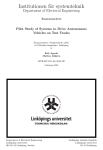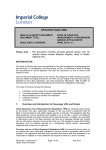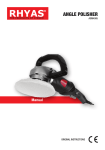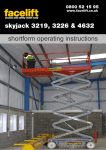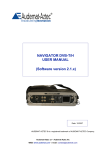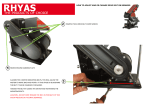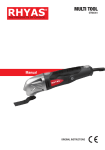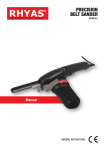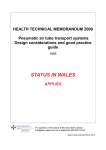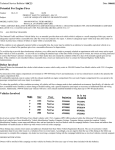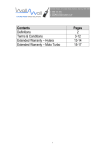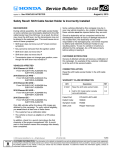Download Manual handling - Workspace
Transcript
ESTATES FACILITIES HEALTH & SAFETY DOCUMENT DOCUMENT TITLE ISSUE DATE & VERSION - CODE of PRACTICE MANUAL HANDLING MAY 2013 v1.2 Please Note – the guidance provided in this Code of Practice pertains only to the Estates Facilities Group and its operations. For Imperial College Health & Safety policies and Codes of Practice go to: http://www3.imperial.ac.uk/safety. INTRODUCTION This Code of Practice (CoP) sets down the standards of safety practice which will be applied for those employees of the Estates Facilities Department who undertake manual handling during the course of their work at Imperial College London. Over and above the general duty of care owed by the College to its staff, students and others under the Health and Safety at Work etc. Act 1974, all work related manual handling and moving & handling tasks are legislated by the Manual Handling Operations Regulations 1992 as amended by the Health & Safety (Miscellaneous Amendments) Regulations 2002. When these activities include lifting equipment, the Lifting Operations and Lifting Equipment Regulations 1998 (LOLER) as amended by the Health & Safety (Miscellaneous Amendments) Regulations 2002 apply. This CoP provides the following: An introduction to manual handling, a definition and the scope of the applicable Regulations The Risk control Hierarchy The methodology for risk assessment in FM and the development of generic and specific risk assessments Responsibilities of duty holders and employees Selection and use of handling equipment Training and competence Monitoring Definition of Manual Handling Manual Handling is defined as ‘The transporting or supporting of a load by one or more members of staff, which includes lifting, putting down, pushing, pulling, carrying or moving, and by reason of its characteristics of unfavourable ergonomic conditions, involves risk, particularly of back injuries to staff.’ They can be further defined as follows: The manual handling of loads by human effort Human effort applied either directly to the load or indirectly (e.g. hauling on a rope or pulling a lever) Both transporting and supporting the load in a static posture (e.g. supported by hands or any other part of the body, shoulder etc.) Page 1 of 17 Manual Handling Code of Practice May 2013 The intentional dropping or throwing of a load into a receptacle or from one person to another Where mechanical assistance is provided, this may only reduce but not eliminate manual handling by human effort, as the load can still need to be moved, steadied or positioned (e.g. the use of a sack barrow or powered hoist). The definition would not include: 1. The application of human effort for operations other than transporting or supporting a load The turning of a starting handle for an engine, lifting a control lever on a machine or the pulling of a rope to lash cargo on the back of a vehicle Loads which result from the use of implements, tools or machines which are being used for their intended purpose, for example a chain saw. The Law and Manual Handling Manual Handling Operations Regulations 1992 (as amended) The main aim is to prevent injury not only to the back, but to any part of the body. The regulations cover all normal working activities and non-routine operations that involve lifting; carrying; pushing or pulling a load; holding or moving by human effort of any moveable object, including a person or animal. The regulation requires that the employer, so far as is reasonably practicable, shall avoid the need for their employees to undertake any manual handling tasks that involve a risk of injury. If a hazardous manual handling task cannot be avoided, a suitable and sufficient assessment shall be undertaken and appropriate steps taken to reduce the risk of injury to the lowest level reasonably practicable. It also states that the employer shall take appropriate steps to provide information on the weight of a load and if applicable its heaviest side. The assessments must be reviewed if it is suspected to be no longer valid or if there have been significant changes made to the manual handling tasks and employees must make full and proper use of any safe system of work provided for their use by the employer when undertaking manual handling operations. Lifting Operations And Lifting Equipment Regulations (LOLER) 1998 (as amended) places duties on any person who uses or has any control of equipment used for lifting or lowering loads at work (objects, persons or animals). The regulations state that the lifting equipment must be positioned and installed so as to be safe. It must be of adequate strength and stability for each individual load raised or lowered and clearly marked with its safe working load. In addition, the load parts and any attachments used in the lifting operation must also be of adequate strength and marked with any information necessary to ensure their safe use. The regulations require that all lifting operations must be properly planned by a competently trained person, appropriately supervised and carried out in a safe way. Lifting equipment and accessories must be thoroughly examined by a competent person at least every 6 months for lifting of people and at least every 12 months for all other types of lifts. 2. Responsibilities of Duty Holders and Employees Heads of Service within Estates Facilities have a responsibility to ensure that all manual handling operations that could result in injury are assessed and adequately controlled. Heads of Service shall ensure that; All manual handling operations that may require a risk assessment are identified; Risk assessments are undertaken and any risk reduction measures identified and implemented; Page 2 of 17 Manual Handling Code of Practice May 2013 All staff who are required to undertake manual handling operations are identified and provided with appropriate training and information, necessary to allow them to carry out the manual handling task allotted to them. (Training and information should be updated as necessary); Staff are made aware of this policy and associated guidance and that they understand it and are able to comply with it: Prompt action is taken to reduce any manual handling hazards and risks identified by employees: Results of risk assessments are recorded and retained for at least five years; Risk assessments are reviewed annually or; when the work changes significantly, following an accident or case of ill health, when the validity of the assessment is suspected Ensure all manual handling accidents and injuries are reported to the FM Services. Employees and students have a responsibility not to undertake any manual handling activities that may cause themselves or others harm and adhere to the information, instruction and training provided. They must immediately bring instances having the potential to cause harm to the attention of their immediate line manager. 3. Manual Handing Risk Assessments The first stage for assessing the risk from manual handling is to determine if the task is hazardous. Some manual handling tasks may not be considered hazardous such as carrying a ream of paper or pushing a light tea trolley. The following methodology is used: Identify hazardous manual handling tasks; Evaluate manual handling risks; Take account of existing precautions; Identify further controls required. The manual handling assessment should include details on: The task being undertaken; The load being handled; The working environment in which the task is being done; The individual capabilities of those undertaking the task; Reducing the risk of injury by considering a variety of elements, including the physical suitability of the employee to undertake the task(s); The clothing, footwear or other personal effects worn by the handler; and The handlers knowledge and training; the results of relevant risk assessment; Whether the handler is of a group of employees identified by a risk assessment as being especially at risk or from results of any health surveillance. The outcome of the assessment should ensure that appropriate steps are taken to reduce the risk of injury to the lowest level. 3. Hierarchy of Controls Where a manual handling task has been identified that is considered hazardous the standard hierarchy of control must be applied as follows: 1. Eliminate the hazard – does the manual handling task need to be carried out? It is often difficult to totally eliminate manual handling; 2. Substitute the hazard with one of lower risk – e.g. if it is possible to reduce the weight of a load to be carried from a 40 kg load into two 20 kg loads; Page 3 of 17 Manual Handling Code of Practice May 2013 3. Use mechanical aids – use of trolleys, Genie lifts, lifting tackle etc. It must be noted that using mechanical aids may introduce new hazards to the task e.g. a genie lift is used on an uneven surface and topples over. Where mechanical aids are to be used those persons using them must receive the appropriate training; 4. Training – all employees of the College undertaking Manual Handling activities must be suitably trained. 4. Generic Risk Assessments In accordance with the Support Services Risk Assessment Code of Practice it is possible to identify a range of tasks that one or more staff undertake on a regular basis which may involve manual handling. Having identified these tasks it is possible to develop a generic risk assessment for each as below: Office / Administration staff Task Lifting & carrying boxes Accessing shelving & Filing Risks Injury from: unstable or heavy load frequent / repetitive task poor handling technique Injury from: Twisting Repetitive movement Poor moving & handling technique Controls Use of handling aids Breaking down contents into smaller loads Appropriate task training Apply ergonomics principles in design of offices / work places Provide safe means of access e.g. kick steps Appropriate task training Maintenance Engineers Task Lifting & carrying tool boxes and bags Risks Injury from: unstable / heavy load poor handling technique transporting on uneven, wet or slippery ground carrying up / down stairs Transporting steps & Ladders Injury from: Unstable loads Load too heavy for single person lift Poor handling technique Assembling / dismantling plant and equipment Injury from: Unstable / heavy loads Repetitive movement Twisting and stretching Poor handling technique Injury from: Unstable / heavy loads Assembling / moving tower scaffolds Controls Use of handling aids i.e. trucks, wheeled tool boxes Breaking down into smaller loads Appropriate task training Plan the route avoiding use of stairs / hazards Two person lift Use of handling aids Appropriate task training Keep extension ladders at their smallest for transportation. Use appropriate lifting equipment Avoid poor postures when exerting excessive force or pressure Two person lift / assembly Page 4 of 17 Manual Handling Code of Practice May 2013 Repetitive movement Twisting and stretching Poor handling technique Working at height Use of hoists / lifting tackle Injury from: Poorly maintained equipment Inappropriate use of equipment Excessive load for equipment Breaking down to smaller loads Appropriate task training Safe working procedures for working at height Regular rest periods from repetitive activities Pre use checks on equipment Regular maintenance Maximum load marked on equipment Appropriate task and equipment training Portering / Support Staff Task Conference room set ups Risks Injury from: Unstable / heavy loads Poor handling technique repetitive movement WEEE recycling e.g. movement of PCs, lab equipment, printers, lights, fridges Injury from: Unstable loads Load too heavy for single person lift Poor handling technique Poor use of handling aids Waste handling and cardboard compacting Moving euro carts Injury from: Unstable loads Repetitive movement Twisting and stretching Lifting too great a load Holding load away from body Poor grip on loads Poor handling technique Injury from: Poorly maintained equipment Inappropriate use of equipment Poor handling technique Use on slopes / unstable ground Controls Use of handling aids i.e. trucks/ sack barrows, Breaking down contents into smaller loads where possible Appropriate task training Two person task Regular rest periods from repetitive activity Two person lift where appropriate Use of handling aids e.g. sack barrow, pallet truck Appropriate task training Avoid use of stairs / steps Always maintain good visibility when carrying items Use of PPE – i.e. gloves to aid grip Breaking down to smaller loads where possible Appropriate task training Safe working procedures for use of compactors and balers Use two person lift on cardboard bales Regular checks on equipment Maximum load marked on equipment Use two person operation Appropriate task training Plan a stable route Page 5 of 17 Manual Handling Code of Practice May 2013 Housekeepers Task Pushing / Pulling Trolleys Lifting & carrying boxes Risks Injury from: Poorly maintained equipment Inappropriate use of equipment Poor handling technique Use on slopes / unstable ground Injury from: unstable or heavy load frequent / repetitive task poor handling technique Controls Regular checks on equipment Maximum load marked on equipment Appropriate task training Plan a suitable route avoiding hazards e.g. speed humps Use of handling aids Breaking down contents into smaller loads Appropriate task training Post Room / Security Task Lifting / transporting sacks / packages Pushing and pulling post trolleys Person handling / first aid techniques 4.1 Risks Injury from: unstable / heavy load poor handling technique holding load away from the body Injury from: Poorly maintained equipment Inappropriate use of equipment Poor handling technique Use on slopes / unstable ground Injury from: Unstable / heavy loads Repetitive movement Twisting and stretching Incorrect use of evac chairs Poor grip on loads Poor handling technique Controls Use of handling aids i.e. trucks, Breaking down contents into smaller loads where possible Appropriate task training Regular checks on equipment Maximum load marked on equipment Appropriate task training Plan a stable route Appropriate task training / First Aid competency Training and practice with evac chairs Appropriate maintenance of evac chairs. Specific Risk Assessments The generic risk assessments above, supported by suitable training, will be sufficient to address the majority of moving and handling activities undertaken by staff in Facilities and Property Management. Managers should ensure that these are brought to the attention of their staff and that staff receive moving and handling training which is commensurate with the roles they undertake. Page 6 of 17 Manual Handling Code of Practice May 2013 Where managers are aware of their staff undertaking tasks which involve moving and handling of items which do not fit the general descriptions above it may be necessary for the manager to carry out a specific risk assessment. This is most likely to be the case in the Maintenance Department where engineering staff could well be required to work on heavy items of plant where it may be necessary to lower / lift and transport the item to a workshop. All managers in the Department are competent risk assessors and should apply the general principles of risk assessment to determine what control measures will be appropriate to minimise the risk of the task to an acceptable level. Managers are advised to consult the College policy and guidance on Manual Handling which can be found at: http://www3.imperial.ac.uk/safety/policies/individualpolicies/manualhandling All specific risk assessments are to be recorded, and for this purpose the HSE have provided a checklist for manual handling of loads (5 page pdf, opens in new window). The HSE also provide a more detailed assessment for pushing and pulling activities. (3 page pdf, opens in new window.) Estates Facilitieshave a member of staff who is a competent moving and handling trained trainer / assessor who is based in Soft Services and can assist managers in conducting risk assessments. 4.2 Dynamic Risk Assessments Dynamic or 60 second risk assessments is a term which describes the process of continually and consciously assessing the hazards present in undertaking a task. All staff are encouraged to apply this process prior to and whilst undertaking a task to ensure that they are always working within their parameters of safety which is governed by any applicable generic risk assessment and their training. Providing staff are confident that the risk of the task is sufficiently controlled through application of the controls identified in the generic risk assessment they should proceed. In the event staff perceive there to be a risk which is not sufficiently controlled they are advised not to proceed unless, through their experience, they can apply additional controls rendering the task safe. 5. Implementing the Code of Practice All managers are duty holders who will be responsible for ensuring that: 6. All tasks carried out by their staff, if not covered by a generic risk assessment, have been suitably risk assessed; All specific risk assessments are recorded and regularly reviewed; All staff have been provided with the appropriate level of instruction and training commensurate with their duties; Suitable and sufficient handling equipment is provided, regularly inspected and maintained in accordance with the LOLER Regulations. Training and Competence All staff will be provided with training which will ensure, so far as reasonably practicable, they are competent and confident to undertake moving and handling within their contracted roles. Due to the range of manual handling operations carried out by staff in the Department a training strategy has been devised which provides for a basic / introductory level of training and an advanced level. Basic / Introductory – all staff will be provided with access to an e-learning course which will provide a base level of knowledge on safe moving and handling and back care. Page 7 of 17 Manual Handling May 2013 Code of Practice Advanced – staff whose roles requires them to undertake more hazardous moving and handling tasks will be provided with training designed to address the risks associated with the tasks performed. Estates Facilities has a member of staff who is a competent moving and handling trained trainer / assessor who can provide some ‘advanced’ training for staff. It is probable that the more advanced / specialist training will need to be purchased from an external provider. Managers intending to purchase advanced / specialist training should consult the trained trainer or the Health and Safety Manager. 7. Good Practice Guidance Safe manual handling has been the subject of much research over recent years particularly by the Health and Safety Executive (HSE) who have campaigned to reduce the number of musculoskeletal injuries amongst the working population. The HSE have subsequently produced the Manual Handling Assessment Chart (Mac Tool) which can be found referenced at Appendix A, or accessed at: http://www.hse.gov.uk/msd/mac/ The MacTool can be helpful in the capacity of conducting risk assessments and risk ranking, it does not provide the answers although there are a number of ‘solutions’ which may guide managers in their considerations regarding control measures. The HSE also make available General Risk Assessment Guidelines which can be found at Appendix B. These guidelines can be used universally by managers and staff to identify what loads should be safe to lift and in what position relative to the torso. These guidelines should be used in conjunction with the other guidance appearing in Appendix B covering lifting and lowering, twisting and, pushing / pulling. The College Occupational Health Department has also produced some useful guidance entitled Moving and Handling Techniques which can be accessed at the link below. These guidelines identify the lifting principles covering a range of varying objects. http://www3.imperial.ac.uk/pls/portallive/docs/1/15879696.PDF 8. Selection and Use of Handling Equipment Where Services or Teams, following a risk assessment, have identified the need to purchase moving and handling aids the following should be considered: Consult employees and safety representatives during assessment and when considering possible solutions. Seek advice on suitability from suppliers/hirers. Request equipment on trial basis, if possible, to check it solves the problem, again involve employees who will be expected to use it. Ask suppliers about other customers so you can see it in use. Check lifting equipment is CE-marked. Consider what maintenance will be required. Check the proposed use will be within the safe working load. Does it suit the area it will be used in? Is there enough room to manoeuvre, enough headroom etc? Does it suit the terrain in terms of stability and ground surface? Consider other risks associated with introducing the lifting aid, e.g. site safety and driver training, concerning use of a fork lift truck. Page 8 of 17 Manual Handling Code of Practice May 2013 9. Lifting Equipment At the point of publishing this Code of Practice there were two specific types of lifting equipment being used in Facilities and Property Management, these are the Scissor Lift and Genie Lift. These lifts are only to be operated by suitably qualified employees who are certificated by the International Powered Access Federation (IPAF) and only where there is a task specific risk assessment in place. The guidance at Appendix C is good practice and must be observed by operatives. 10. Monitoring and Review Both reactive and pro-active methods will be used to determine the degree to which staff in Estates Facilities are operating in accordance with this Code of Practice. Reactive Monitoring… will consist of analysing accidents and incidents that have occurred across the College as this may indicate that the risk assessment for the activity being undertaken when the accident / incident occurred is no longer valid and will need additional control measures to be implemented. It could also indicate that the training provided is in some way inadequate or that the learning has not been transferred in to the work place. Accidents and incidents should be investigated proportionately and any relevant findings used to review the safe system of work pertaining to the activity. Pro-active Monitoring… is an ongoing process which involves observing staff at work to ascertain whether they are applying the safe working practices as advocated in risk assessments, as directed by their managers and within training received. Risk assessments should also be periodically reviewed to ensure they remain valid in respect to the task being undertaken and the assessed risk. Page 9 of 17 Manual Handling Code of Practice May 2013 Appendix A The HSE Mac Tool Manual handling assessment chart (MAC) tool The MAC tool has been developed by the HSE to help the user identify high risk workplace manual handling activities. The tool can be used to assess the risks posed by lifting, carrying and team manual handling activities. It is designed to help you understand, interpret and categorise the level of risk of the various known risk factors associated with manual handling activities. The MAC incorporates a numerical and a colour coding score system to highlight high risk manual handling tasks. The MAC tool is available at the following link: http://www.hse.gov.uk/msd/mac/index.htm This website provides information and assistance regarding the use of the MAC, when assessing the risks associated with manual handling. It outlines why the MAC was developed, how the MAC works and how to use it. General information is provided on the risks associated with manual handling and on an employers duties under the Manual Handling Operations Regulations (as amended) 1992 (MHOR). Page 10 of 17 Manual Handling Code of Practice May 2013 Appendix B General Risk Assessment Guidelines There is no such thing as a completely ‘safe’ manual handling operation. But working within the following guidelines will cut the risk and reduce the need for a more detailed assessment. Figure 1 Lifting and lowering Use Figure 1 to make a quick and easy assessment. Each box contains a guideline weight for lifting and lowering in that zone. (As you can see, the guideline weights are reduced if handling is done with arms extended, or at high or low levels, as that is where injuries are most likely to occur.) Observe the work activity you are assessing and compare it to the diagram. First, decide which box or boxes the lifter’s hands pass through when moving the load. Then, assess the maximum weight being handled. If it is less than the figure given in the box, the operation is within the guidelines. If the lifter’s hands enter more than one box during the operation, use the smallest weight. Use an in-between weight if the hands are close to a boundary between boxes. The guideline weights assume that the load is readily grasped with both hands and that the operation takes place in reasonable working conditions, with the lifter in a stable body position. Twisting Reduce the guideline weights if the handler twists to the side during the operation. As a rough guide, reduce them by 10% if the handler twists beyond 45o, and by 20% if the handler twists beyond 90o. Frequent lifting and lowering The guideline weights are for infrequent operations - up to about 30 operations per hour where the pace of work is not forced, adequate pauses to rest or use different muscles are possible, and the load is not supported by the handler for any length of time. Reduce the weights if the operation is repeated more often. As a rough guide, reduce the weights by 30% if the operation is repeated once or twice per minute, by 50% if the operation is repeated five Page 11 of 17 Manual Handling May 2013 Code of Practice to eight times a minute, and by 80% where the operation is repeated more than 12 times a minute Pushing and pulling The task is within the guidelines if the following figures are not exceeded: Men Women Force to stop or start the load 20 kg 15 kg Sustained force to keep the load in motion 10 kg 7 kg See ‘Good handling technique for pushing and pulling’ for some examples of forces required to push or pull loads. Using the results: Do I need to make a more detailed assessment? Using Figure 1 is a first step. If it shows the manual handling is within the guideline figures (bearing in mind the reduced limits for twisting and for frequent lifts) you need not do any more in most cases. But you will need to make a more detailed assessment if: the conditions given for using the guidelines (eg that the load can be readily grasped with both hands) are not met; the person doing the lifting has reduced capacity, eg through ill health or pregnancy; the handling operation must take place with the hands beyond the boxes in the diagram; or the guideline figures in the diagram are exceeded. For pushing and pulling, you should make a more detailed assessment if: o there are extra risk factors like uneven floors or confined spaces; o the worker can’t push or pull the load with their hands between knuckle and shoulder height; o the load has to be moved for more than about 20 m without a break; or o the guideline figures in the table are likely to be exceeded. Page 12 of 17 Manual Handling Code of Practice May 2013 Basic Manual Handling Technique In order to lift and carry safely, employees must adopt a safe handling technique. This can be done in the following stages: 1. 2. 3. 4. 5. 6. 7. Consider the task, load, environment and individual – is the load especially heavy?, is the load difficult to handle i.e. has sharp edges, is unstable?, will the environment affect the lift i.e. small amount of space to manouvere in? etc Position your feet correctly – feet should be shoulder width apart to ensure you maintain your centre of gravity and balance. Bend the knees keeping the back straight whilst retaining its natural curves. Take a firm grasp of the object to be lifted – use any available handles to ensure a good grip Lift by straightening the legs – the strength for the lift mist come from the legs and not the back. Move the load keeping it as close to your body as possible and at waist height – in this position it is closer to your centre of gravity and therefore easier to carry. When putting the item down, reverse the above moves, do not jerk it down but bend the knees once again if necessary. Page 13 of 17 Manual Handling Code of Practice May 2013 Appendix C Guidance note Guidance note for Use of Genie Lift Personnel Training Employees in team of two General H&S induction, appropriate professional qualifications, site induction IPAF training Plant, Equipment and Materials Work Equipment and Plant Genie Lift Materials Dependant on task being undertaken Personal Protective Equipment Harness and lanyard Hazards Relevant Assessments Falls from height, physical injury Guidance Undertake pre – inspection check (attached) 1. Perform function test 2. 3. Both feet must be firmly on the platform and the floor kept free of clutter. No sitting, standing or climbing on the bucket walls. Keep hands and fingers away from pulleys and carriages. Avoid leaning ladders against the Genie lift. Do not leave the machine unattended while loaded. 4. 5. Avoid standing underneath the Genie lift while the bucket is raised. Make sure there are no obstructions below when lowering the bucket. Do not use the lift to raise heavy equipment loads and do not exceed the load capacity of 300 pounds. Do not adjust outriggers with a raised or occupied platform. Avoid operating the Genie lift outside in heavy wind, snow or rain. If the Genie lift begins to sway, immediately lower the bucket. Do not operate near or under low electrical lines. Page 14 of 17 Manual Handling Code of Practice May 2013 Pre Inspection Checklist Do Not Operate Unless: You learn and practice the principles of safe machine operation contained in the operator’s manual. Avoid hazardous situations. Always perform a pre-operation inspection. Know and understand the pre-operation inspection before going on to the next section. Always perform the function tests prior to use. Inspect the workplace. Only use the machine as it was intended. Be sure that the operator’s, safety and responsibilities manuals are complete, legible and in the storage container located on the platform. Be sure that all decals are legible and in place.. Check for battery fluid leaks and proper fluid level. Add distilled water if needed. See Maintenance section of the operators manual AC & DC models: Check for hydraulic oil leaks and proper oil level. Add oil if needed. See Maintenance section of the operators manual RT base models: Check for proper tire pressure. Add air to tires if needed. See Maintenance section of the operators manual Air models: Check the oil level of the airline lubricator. See Maintenance section of the operators manual Air models: Check the oil lubricator canister drip rate. Adjust as needed. See Maintenance section of the operators manual Air models: Check the air filter/regulator canister. Drain water as needed. See Maintenance section of the operators manual Check the following components or areas for damage, improperly installed or missing parts and unauthorized modifications: Electrical components, wiring and electrical cables AC & DC models: Hydraulic power unit, hoses, fittings and cylinder Air models: Air power unit, airlines, fittings and cylinder Platform entry mid-rail or gate Sequencing cables and pulleys Lifting chains and idler wheels Nuts, bolts and other fasteners Mast columns and counterweight Breather cap Outriggers, levelling_ jacks and footpads Adjustable glide pads Check entire machine for: Dents or damage Corrosion or oxidation Cracks in welds or structural components Inspect and clean battery terminals and all battery cable connections. Be sure that all structural and other critical components are present and all associated fasteners and pins are in place and properly tightened. Page 15 of 17 Manual Handling Code of Practice May 2013 Guidance note Guidance note for Use of Scissor Lift Personnel Training Employees in team of two General H&S induction, appropriate professional qualifications, site induction IPAF training Plant, Equipment and Materials Work Equipment and Plant Scissor lift Materials Dependant on task being undertaken Personal Protective Equipment Harness and lanyard Hazards Relevant Assessments Falls from height, physical injury Sequence of Tasks Undertake pre – inspection check (attached) 6. Perform function test 7. 8. Perhaps the biggest risk in using scissor lifts lies in the possibility of a tip-over. Because the lift raises straight up off a wheeled base and has such weight at the top, it can easily roll under the wrong conditions. Unlike a standard ladder, the scissor lift does not have anything to lean on to support its full weight at an angle; safely evaluate the area on which you position the lift. Set up your lift on completely flat ground devoid of any holes or bumps. Additionally, place your scissor lift on solid ground; soft ground can give way under the weight, and even the slightest shift in slope can cause an extended lift to tip sideways and throw you out. Most heavy-duty models also come equipped with extendable support arms; extend them to their fullest capacity, and secure them firmly and flatly against the ground. If even one of these arms does not lay flat on the ground when extended and lowered, do not operate the lift. 9. To avoid a fall, always remain on the basket floor itself and refrain from trying to stand on the railings or anywhere else. Though all newer models of lifts should have fully insulated buckets, make frequent checks to ensure that the entire lift remains in good condition, well insulated and free from threat of electrocution---a common threat when using scissor lifts near wiring or power lines. Finally, when working on or near any power lines or powerful wiring, de-energize the lines completely or use the proper equipment to handle them. Tell anyone on the ground nearby to keep a safe distance from the lift to avoid accidental electrocution should the lift's insulation fail. Page 16 of 17 Manual Handling Code of Practice May 2013 Pre Inspection Checklist Do Not Operate Unless: You learn and practice the principles of safe machine operation contained in this operator's manual. Avoid hazardous situations. Always perform a pre-operation inspection. Know and understand the pre-operation inspection before going on to the next section. Always perform function tests prior to use. Inspect the workplace. Only use the machine as it was intended Pre-operation Inspection Be sure that the operator’s, safety and responsibilities manuals are complete, legible and in the storage container located in the platform. Be sure that all decals are legible and in place. Check for hydraulic oil leaks and proper oil level. Add oil if needed. See Maintenance Section in the user manual Check for battery fluid leaks and proper fluid level. Add distilled water if needed. See Maintenance section in the user manual. Check the following components or areas for damage, improperly installed or missing parts and unauthorized modifications: Electrical components, wiring and electrical cables Hydraulic hoses, fittings, cylinders and manifolds Battery pack and connections Drive motors Wear pads Tires and wheels Ground strap Limit switches, alarms and horn Alarms and beacons (if equipped) Nuts, bolts and other fasteners Platform entry chain or gate Brake release components Safety arm Platform overload components Pothole guards Platform extension Scissor pins and retaining fasteners Platform control joystick Check entire machine for: Cracks in welds or structural components Dents or damage to machine Excessive rust, corrosion or oxidation Be sure that all structural and other critical components are present and all associated fasteners and pins are in place and properly tightened. Be sure side rails are installed and bolts are fastened. Be sure that the chassis trays are closed and latched and the batteries are properly connected. Note: If the platform must be raised to inspect the machine, make sure the safety arm is in place. Page 17 of 17 Manual Handling Code of Practice May 2013

















